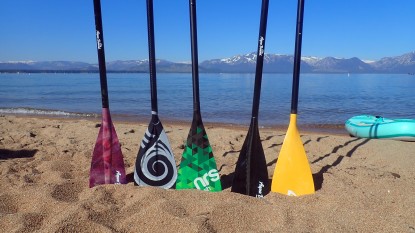NRS Rush Review
Our Verdict
Our Analysis and Test Results
The Rush stood out because of its lightweight fiberglass construction, weighing in at just 1.3 pounds. With a flat, teardrop blade design and minimal offset, our reviewers weren't particularly impressed by its performance for recreational paddling, but that's not to say it won't get you from Point A to Point B.
Performance
The symmetrical, teardrop blade shape didn't match the efficient paddling performance of other models in this review. The broad surface area along the bottom of the paddle catches a lot of water immediately, which requires plenty of power to move. The steeper offset angle (7-degrees) and flat face are also meant to maximize power, but they don't do much to control water flow. As a result, if your stroke varies from side to side, the paddle may slice and flutter.
Our testers found that paddles with a bit of variation in the blade shape, like dihedral designs, are easier to paddle. They require less force and reduce flutter. Additionally, although the Rush's 7-degree offset allows you to generate a lot of power in the water, it requires more strength and precision than other products that feature a bit more offset.
This paddle is more optimized for surfing, where you need power at your fingertips to catch a wave than for a casual paddle. If you are an experienced paddler who enjoys a slower cadence and a more powerful stroke, this paddle could work well. But it's not suited for the majority of casual users as it requires more work at a higher price than most of our other options.
Weight
This is where the Rush really shines. At just 1.3 pounds, it's one of the lightest paddles in the review. As a result, the paddle feels light in your hand. For recreational paddlers, this lightweight might not be noticeable immediately, but it will be felt over the course of a long session on the water.
If you can deal with a little more weight, you can find cheaper paddles that are better suited for relaxing days on the water. For paddlers who are focused on reducing weight, you might want to splurge and go for the slightly lighter paddle but you can expect it to come with a fairly significant jump in price.
Ease of Adjustment
The Rush features 18 inches of adjustment, which is one of the longest adjustment ranges in our review. However, it only features measurement marks for the paddle length itself (in inches and centimeters), so you have to know what height works for you.
Although this is a seemingly minor difference, it makes quickly adjusting the paddle between novice users of different heights much more time-consuming. This, combined with the paddle's locking mechanism (which we discuss in detail below), makes the adjustment of this paddle a little slower than other models.
Locking Mechanism
The Rush features an Easy Clip adjustment mechanism that is comparable to the Twin Pin mechanism found on many other models. Essentially they all have connection point midshaft with a lever. Release the lever to slide the paddle to the desired height before closing it again.
This is a pretty clunky locking mechanism when compared to the handle-based LeverLock found on the top-tier paddles. The many moving parts also create play in the locking mechanism, but it works overall.
Aesthetics
While the handle and shaft of the Rush are nothing to write home about in terms of looks, we did like the patterned blade of this paddle quite a lot. The geometric green and black pattern definitely stands out, but other paddles were a little better at turning heads, namely the ones with natural wood veneer. However, the Rush is a good option if you prefer a more subdued style statement.
Value
The Rush is on the middle-to-high end of our price range. While the paddle is light, it doesn't feature the carbon fiber construction of some of the other paddles in the review. However, there are other paddles in this price range that are both lighter and offer better paddling performance, which may serve you better.
Conclusion
The Rush is a lightweight, compact option meant for power and precision. This works well if you're trying to catch waves but can be overly tiring on flatwater or longer paddles. But, if you like paddling with power and prefer a lightweight set up, this could be a good option.









